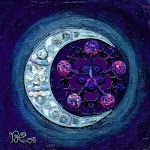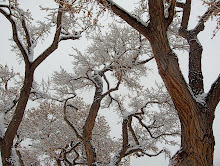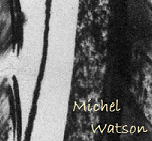The beauty and grace
as you hang there
the light in your eyes
as you shine
the tribute I make now
to your glowing aura
you certainly brighten
my nights
you crest and wane
and turn the tides
you hang in place
suspended in space
to delight and enlighten
I live for such moments
to stand in your presence
once more.
By Karin Rochelle
Please visit her blog for more information at: http://echoesofavampire.blogspot.com/
Tuesday, February 23, 2010
Thursday, February 18, 2010
Celtic Tree Month of Ash Begins Today

The ash tree was one of the sacred Druid trees. On the Celtic calendar, the month of Ash begins on Feb. 18 and goes through March 17. This is a great time to do magic that is associated with the inner self, ocean rituals, prophetic dreams and spiritual journeys.
The Ash tree represented growth, expansion, and higher perspective, to the Celts. Ash was often used for making both mundane and magical tools like wands, brooms or spears.In ancient Celtic Ireland, the Ash tree was so sacred, that people refused to cut them down even when wood was scarce. The ash also gives its name to the letter N in the ogham alphabet. Together with the oak and thorn trees, the ash is part of a magical trilogy of sacred trees to the Druids. It is also said that if you place Ash berries in a cradle, it protects the child from being taken away by mischevious Faeries.
To celebrate the Celtic tree month of Ash, do a ritual or meditation to the Ash full moon which falls on Feb 28.
Blessings )O(
Photo courtesy of Woodland Trust
Monday, February 15, 2010
Magickal News Reel
Neo-Pagans Get Worship Circle at Air Force Academy
Finding faith: Pagans explore spirituality
Mystical, magical: Learn lore of love spells and potions
Huge crowds turn out for Marsden’s Imbolc Festival
Morrinsville prepares for pagan invasion
Witches and Jedis put hex on UK census
What we can look forward to in the year of the Tiger
Flower lore's mythical roots
Lost City of Atlantis could be buried in Southern Spain
Love of the Goddess examines Artemis, Goddess of the Hunt
Love Spells from Kiki's Cauldron
Wheel of the Year from CricketSong
Valentine's Day with Michelle
Spiritual Sexuality with Leviathan
Finding faith: Pagans explore spirituality
Mystical, magical: Learn lore of love spells and potions
Huge crowds turn out for Marsden’s Imbolc Festival
Morrinsville prepares for pagan invasion
Witches and Jedis put hex on UK census
What we can look forward to in the year of the Tiger
Flower lore's mythical roots
Lost City of Atlantis could be buried in Southern Spain
Love of the Goddess examines Artemis, Goddess of the Hunt
Love Spells from Kiki's Cauldron
Wheel of the Year from CricketSong
Valentine's Day with Michelle
Spiritual Sexuality with Leviathan
Tuesday, February 2, 2010
The Bright One: highlight on Brigid this Imbolc
Brigid, gold-red woman,
Brigid, flame and honeycomb,
Brigid, sun of womanhood,
Brigid, lead me home.
You are a branch in blossom.
You are a sheltering dome.
You are my bright precious freedom.
Brigid, lead me home.
-From The Goddess Path by Patrica Monaghan

The Celtic Goddess Brigid is honored on Imbolc. Brigid is the Celtic Goddess of fire. Her name means “bright one,” and she is one of the most worshiped goddesses in Celtic culture. Brigid appears as a triple goddess: she is goddess of inspiration and poetry; goddess of healing and fertility; goddess of smithcraft and metalwork. Her magickal upbringing gives her a brightness, divinity, and the powers of prophecy.
She is the daughter of Dagda, the tribal chief of the Tuatha de Danaan and “good-god” of magick and abundance, thus making her an immortal member of the magickal founding troop of Ireland. Brigid was born in a druid’s household, and raised on the milk of Otherworldly cows. She was invoked by women giving birth, and worshipped on Imbolc, as she is a symbol of abundance and fertility. In myth, she had the ability to fill a lake with milk from her cows, which she milked three times a day. She taught the magick of fire and the art of metalworking to smith crafters. For poets, bards, and singers, she whispered divine inspiration. Worshipped on Imbolc, Brigid gives us the promise of a new spring, and inspires us to prepare for abundance and success in the coming warm months.
You can call upon her to help give you inspiration for creative work as well as give you strength and energy. She is often called to help with healing, and called for comfort during times of grieving. At Imbolc, you can show reverence to her by placing her symbols on an altar. The following are suggested decorations for Brigid:
*White and candles surrounded by lavender.
*Metal-crafted objects, or smith crafting tools.
*A cauldron with burning incense (dragon’s blood resin and red sandalwood are excellent for Imbolc)
*A glass of milk.
*Pure water in a silver bowl.
*Blackberry, which was sacred to Brigid, and can be used to attract wealth and healing.
*Brigid's Cross
*Brigid Corn Dolly
In her honor, take a moment to shut off all the lights in your house. Turn off your cell phone, computer, and television. Illuminate your home with white candles, and sit in peace and quiet for a moment, thanking Brigid for light, inspiration, health, and abundance. Consider writing an invocation or poem in her honor, and enjoy the growing warmth and light of the year. Many blessings to you on Imbolc.

Bibliography
Green, Miranda. Dictionary of Celtic Myth and Legend. London: Thames and Hudson, 1992.
Hopman, Ellen Evert. A Druid’s Herbal For the Sacred Wheel of the Year. Rochester, Vermont: Destiny Books, 1995.
Monaghan, Patricia. The Goddess Path: Myths, Invocations, and Rituals. St. Paul, Minnesota: Llewellyn Publications, 1999.
Brigid, flame and honeycomb,
Brigid, sun of womanhood,
Brigid, lead me home.
You are a branch in blossom.
You are a sheltering dome.
You are my bright precious freedom.
Brigid, lead me home.
-From The Goddess Path by Patrica Monaghan

The Celtic Goddess Brigid is honored on Imbolc. Brigid is the Celtic Goddess of fire. Her name means “bright one,” and she is one of the most worshiped goddesses in Celtic culture. Brigid appears as a triple goddess: she is goddess of inspiration and poetry; goddess of healing and fertility; goddess of smithcraft and metalwork. Her magickal upbringing gives her a brightness, divinity, and the powers of prophecy.
She is the daughter of Dagda, the tribal chief of the Tuatha de Danaan and “good-god” of magick and abundance, thus making her an immortal member of the magickal founding troop of Ireland. Brigid was born in a druid’s household, and raised on the milk of Otherworldly cows. She was invoked by women giving birth, and worshipped on Imbolc, as she is a symbol of abundance and fertility. In myth, she had the ability to fill a lake with milk from her cows, which she milked three times a day. She taught the magick of fire and the art of metalworking to smith crafters. For poets, bards, and singers, she whispered divine inspiration. Worshipped on Imbolc, Brigid gives us the promise of a new spring, and inspires us to prepare for abundance and success in the coming warm months.
You can call upon her to help give you inspiration for creative work as well as give you strength and energy. She is often called to help with healing, and called for comfort during times of grieving. At Imbolc, you can show reverence to her by placing her symbols on an altar. The following are suggested decorations for Brigid:
*White and candles surrounded by lavender.
*Metal-crafted objects, or smith crafting tools.
*A cauldron with burning incense (dragon’s blood resin and red sandalwood are excellent for Imbolc)
*A glass of milk.
*Pure water in a silver bowl.
*Blackberry, which was sacred to Brigid, and can be used to attract wealth and healing.
*Brigid's Cross
*Brigid Corn Dolly
In her honor, take a moment to shut off all the lights in your house. Turn off your cell phone, computer, and television. Illuminate your home with white candles, and sit in peace and quiet for a moment, thanking Brigid for light, inspiration, health, and abundance. Consider writing an invocation or poem in her honor, and enjoy the growing warmth and light of the year. Many blessings to you on Imbolc.

Bibliography
Green, Miranda. Dictionary of Celtic Myth and Legend. London: Thames and Hudson, 1992.
Hopman, Ellen Evert. A Druid’s Herbal For the Sacred Wheel of the Year. Rochester, Vermont: Destiny Books, 1995.
Monaghan, Patricia. The Goddess Path: Myths, Invocations, and Rituals. St. Paul, Minnesota: Llewellyn Publications, 1999.
Subscribe to:
Posts (Atom)



















































